How to Get Buy-in For Your A/B Testing Strategy

A/B testing strategies only work if the whole team is bought in. To earn executive attention and support, teach people throughout your company how A/B tests can help them. Show marketers how testing lifts conversions, engineering teams how it shortens development cycles, and leaders how it makes apps and sites more profitable.
You may have to do some selling. But good salespeople are really just good educators, and the facts are on your side. Think of yourself as a friendly teacher trying to help everyone solve their problems with A/B tests.
Go for gold and try to get every team engaged. The more bought-in your whole company is, the better it all works. Everyone will need to accept valid test A/B test results, make product or messaging changes, and “pursue continued iterations of testing” wrote Shutterstock VP of Product Wyatt Jenkins in the Harvard Business Review.
Here are three steps to earning buy-in for your A/B testing strategy:
Step 1. Build a case
To persuade people, think about what your buyers (in this case, others within your company) want. Before you speak with anyone, memorize the acronym WIIFM, short for ‘What’s in it for me?’ That’s the question everyone you propose your A/B testing strategy to is thinking, not because they’re selfish, but because they’re busy and have a job to do. The more clearly you frame your A/B testing strategy in terms of what’s in it for them, the easier you make it for them to understand and support your plan.
Here’s what each team may be thinking about:
Marketing – Get more people using the product
- Drive pipeline
- Increase conversions
- Increase retention
- Increase site or app usage
- Increase engagement
- A/B testing metrics
Product – Make the product better
- Make product launches more successful
- Build the best possible product road map
- Improve profitability
- Improve satisfaction
- Increase retention
- Increase site or app usage
- Collect more data
- Use existing data better
Engineering – Improve the engineering process
- Improve product quality
- Hit deadlines
- Reduce development cycles
- Attract talented engineers
- Work on exciting projects
- Use exciting tools
Finance – Make more money
- Increase profitability
- Decrease expenses
- Reduce risk
Business or analytics – Make better decisions
- Improve decision making throughout the company
- Collect more data
- Reduce risk
Go beyond generalities and ask other teams about their priorities. What challenges do they run into? What comes up over and over in their meetings? Each department’s top initiatives are rarely a secret. If a marketing executive wants to increase retention, they’ll probably talk about it in the halls and post about it on LinkedIn. Use everything available to tailor your case to things they care about.
“We know more about our customers, statistically, than anyone else in our market. It also means that we can run more experiments with statistical significance faster than businesses with less user data. It’s one of our most important competitive advantages.”
– Wyatt Jenkins, VP of Product, Shutterstock
Arm yourself with statistics, articles, and case studies
Use data to argue your case. There are endless examples of A/B test successes that you can look to. The more closely related they are to your company’s use case and vertical, the more convincing they’ll be.
A/B testing statistics:
- Better UX design as a result of user testing can increase a company’s conversion rate 400 percent – Entrepreneur
- 70% of consumers find push notifications valuable – Responsys
- The average user retention rate for apps is 38% – Statista
- Bing runs more than 1,000 A/B tests per month – Marketing Mag
A/B testing articles:
- 5 personalization lessons from Spotify, Pinterest, Netflix, and more
- 16 inspiring examples of app personalization
- Creating magical moments with customer feedback
- Should you build or buy A/B testing software?
- More
A/B testing case studies:
Ticketing app
TodayTix increased purchases 9% with A/B testing
Foodservice
Chick-Fil-A increased mobile payments 6% with A/B testing
Retail and E-commerce
Good&Co increased user engagement 27% with A/B testing
Lottery.com increased click-throughs (CTR) 60% with A/B testing
Social network
Houseparty increased first-day friend requests 2x with A/B testing
To make a rock-solid case, take one of the case studies above and calculate what that result would mean to your business. How much more might revenue might the company book with 6% more mobile payments?
2. Find your allies
Put out feelers to those on your team and on others to see who else is equally interested in A/B testing. A salesperson would call these individuals champions, or internal advocates. Ask them to join you in building a case to secure the funds and political capital necessary to buy an A/B testing software.
Together, build an A/B test strategy deck that includes:
- Expected use cases, payoffs, and return on investment (ROI)
- Statistics and case studies
- Your A/B testing metrics and framework
- Your implementation plan, including a timeline
- What you need to begin with total cost of ownership (TCO)
- Any nice-to-haves, like A/B testing analytics
The more specific you can be in your deck, the better. Tailor the presentation to your company and the teams and individuals you’ll present to, like your boss or the CEO. Don’t promise results you can’t deliver, but demonstrate what you think is reasonable given several levels of investment. Give 2 to 3 options, including your ideal scenario (full A/B test implementation with services so your analytics partner can implement it for you) and a minimum-viable option: A limited trial.
Running a small, inexpensive tests on your own can create the validity you need to inspire executive buy-in. To wit: After months of waiting for a response, an engineer at Microsoft took his idea for improving Bing ads and implemented a simple A/B test, reports the Harvard Business Review. The results were so incredible that at first, teams thought a bug hit the system. It hadn’t, it was just a very small but very impactful change to the search box. It took almost no investment—but woke management up to the power of A/B testing.
3. Ask for a meeting (or five)
Ask someone above you to help secure meetings with executives. Salespeople call these people sponsors—they’ll back your idea, and perhaps even join you in the pitch. Managers, mentors, and champions are a great fit.
Book a meeting and then use your remaining time to ask around for feedback. A diversity of ideas helps you battle test your message. Ask it from all levels, about plans, design, software, needs, and company capabilities. You may learn your company has particular data compliance requirements that affect your choice of vendor. Or you may learn that someone has previous experience at a company with an A/B testing software, and can attest to its usefulness.
You may not hear the answers you want—some may disagree with you, or suggest different KPIs, or ask a question you don’t have an answer too, but this is good. Feedback helps inform and prepare you for the real conversation.
If you get the buy-in you need the first time around, consider it a wild success. At most companies, it’ll take two or three meetings and months before a decision is reached. But once it is, you’re off to the races using A/B testing to make your app or site more profitable—just as promised.
Start A/B testing fast with Taplytics — Learn more
